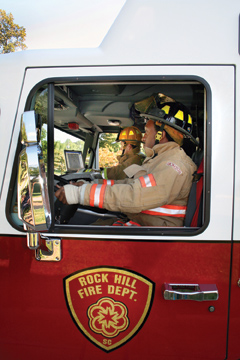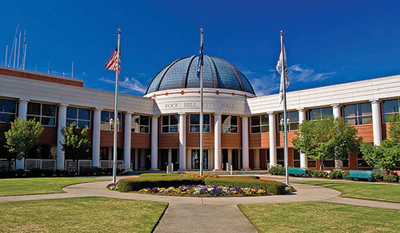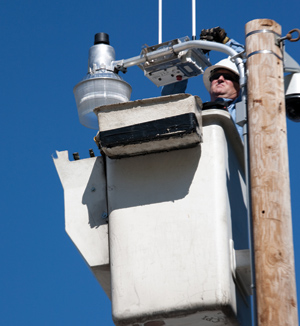The City of Rock Hill, South Carolina’s utility provides electric, water, and sewer service to approximately 95,000 residential and commercial customers within the city and surrounding suburbs. The utility developed goals to offer customers more choices and improve services. To achieve these, utility executives determined they needed to get more energy consumption data, manage it faster, and make it available to customers. This is how they did it…
The utility determined that to provide these new and improved services it would need to deploy several new systems. First, an Automated Metering Infrastructure (AMI) system, including replacement of power and water meters with digital meters that could be centrally monitored, 24/7. With the ability to monitor meters centrally, outages could be quickly detected and the location pinpointed – rather than waiting for customers to call and report a problem. In addition, by understanding power usage, engineers would be able to perform real-time analysis of transformer loading and better manage power through the distribution system.
Another key system needed was a new customer interface to provide customers with easy access to their own utility usage information. The utility decided on a web-based portal that would allow customers to view their usage and make decisions on how to conserve usage resulting in a lower utility bill. In addition to usage information, the utility wanted to enable customers to submit service requests such as cut-off, which would automatically create a final bill.
Finally, the utility determined it needed a high-speed communications network that would provide reliable and secure communications between the utility and its customers.
Following a successful trial in downtown Rock Hill, Tropos Networks was awarded the contract and Rock Hill became the first city in the world to implement city-wide automated metering infrastructure (AMI) and a fixed water leak detection system.
Now in Full Deployment
Today, the wireless broadband network covers 32 square miles with backhaul connections to the city’s fiber ring. The utility has achieved both its goals of improving customer service and making energy consumption information available to customers. Utility customers are now able to view in real time their energy use and how making changes affects their consumption. For example, they can turn off their water heaters for a few hours, look at their meter data, and see the results immediately. Or, a customer can adjust his or her thermostat from work if he or she is coming home earlier or later than usual, just by logging into the Rock Hill utility portal and adjusting the temperature accordingly.
Remote monitoring is a huge advantage for the utility as well; utility executives estimate that they save approximately $50 to $60 per call by remotely reading the meters in the area, which also improves customer satisfaction. The process and time for change in service or name requests is now streamlined and utility representatives can access real-time reads without a truck roll.
In addition, mobile utility workers enjoy greater mobility and are able to work more efficiently. For instance, instead of waiting for calls from customers about a power failure, alerts are immediately detected centrally whenever a failure occurs. Outage location is immediately pinpointed using the Geographic Information System (GIS) and field workers can physically see where all the meters are located enabling problems to be addressed much faster.
Before a truck leaves a neighborhood following an outage, the utility can determine if all of the meters are up and working or if a few have been missed, rather than waiting to see if complaints come in. This has resulted in substantial savings on the cost of a truck roll while also increasing customer satisfaction.
Expanding Use of the Network for Public Safety and Public Works

The Rock Hill City Council adopted the concept of using the wireless broadband network as a foundation in its strategic plan to improve a wide range of municipal services in the city.
Public safety was identified as a top priority – police and fire departments backed the technology and worked to get the police and fire departments on the wireless broadband network by implementing laptops in vehicles that provide real-time information in the field – from crime data to mug shots and building blueprints. Previously, the police had not been able to access this information from the field due to limited network bandwidth. Now installed in police vehicles, mobile routers enable high-speed access to critical state (i.e. SLED – South Carolina State Law Enforcement Division) and federal databases, along with the ability to remotely view security surveillance cameras located in parks and other public places, in real-time.

The fire department also installed on-board mobile routers and uses the network, en route, to download a building’s blueprint before arriving at the scene, so they know exactly what they’re going to face in terms of the building structure – types of materials, storage, and locations. Instead of having a person relay the building layout over the phone or pulling out paper maps to identify locations of fire hydrants, fire officials have updated information at their fingertips, saving critical time in emergency situations.
The city’s building inspection and code inspection departments also benefit from being able to ‘virtually’ extend their offices into the field. Inspectors can sign off on paperwork from their vehicles as soon as they finish inspections rather than waiting until the end of the day, speeding up the reporting process for builders and contractors. A contractor can access the paperwork online after an inspection to see whether their project was approved or rejected and why, usually within minutes of the inspection.

The sanitation department has received an efficiency boost as well using the wireless broadband network with an application written by the city. Previously, sanitation workers had no way of knowing which homeowners had paid for or dropped service; the city estimated that approximately one thousand homes were getting free garbage pickup each month.
Now, using GIS and GPS, sanitation trucks go out into the community and they have an onboard computer that shows them their location using the GPS data. The worker just has to click on a house on a map screen and the system automatically issues a bill for the location – no commands, no typing, just a touch screen.

Another application developed by the city that uses the wireless broadband network enables mobile city workers to send a work order to the appropriate city department when there are problems such as potholes, streetlights that are out, or other hazards. Instead of taking time to call in the problem – the GPS pinpoints where the workers are and records the GPS location of the utility vehicle. This single application has improved the efficiencies of taking work orders and enabled faster response to problems.
Public Access Hot Zones
Rock Hill citizens and visitors are also provided free Internet access at various hot zones around town such as City Hall, as well as other city facilities and parks. At outdoor sporting events, officials can post game information and scores for people monitoring the game remotely as well as research rules and regulations; fans, and press in the stands can access the Internet and stay connected as they watch games.
Conclusion
Rock Hill’s success is largely because the City Council was very supportive and willing to go out on a limb to do something that nobody else was doing, at the time. Once the momentum got going and the utility started showing some of the benefits, people came on board and came up with ideas of their own on how to use the broadband network to improve quality of life in the community – and that’s when it really took off.
Most cities and governments don’t know exactly what they want out of a communications network because they don’t know what’s possible. Rock Hill is an example of a forward-looking city that created a broadband future benefiting the entire community that started with needs identified by the utility – control meter reading costs, improve billing accuracy and encourage resource conservation. The utility took the lead, backed by the City Council, in creating a citywide broadband network foundation that has led to improved efficiencies and reduced operational costs for many city services.
About the Author

Jimmy Bagley, is currently employed with the City of Rock Hill as the Public Services Administrator/CIO, where he has responsibility for the Utilities Department, Public Works Department and the Information Technology Services Department. He previously served as the Utilities Director for the City of Rock Hill with responsibilities in water, sewer, electric, and storm water.
Mr. Bagley is a past president of the South Carolina Society of Professional Engineers, Catawba Chapter, where he was voted young engineer of the year in 1993. Mr. Bagley has also presided over the South Carolina Association of Municipal Power Systems Board and is a member of the American Public Power Association’s Transmission & Distribution Committee. He has been a member of the IEEE-Power & Energy Society since 1989.







